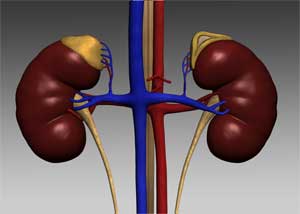- Home
- Editorial
- News
- Practice Guidelines
- Anesthesiology Guidelines
- Cancer Guidelines
- Cardiac Sciences Guidelines
- Critical Care Guidelines
- Dentistry Guidelines
- Dermatology Guidelines
- Diabetes and Endo Guidelines
- Diagnostics Guidelines
- ENT Guidelines
- Featured Practice Guidelines
- Gastroenterology Guidelines
- Geriatrics Guidelines
- Medicine Guidelines
- Nephrology Guidelines
- Neurosciences Guidelines
- Obs and Gynae Guidelines
- Ophthalmology Guidelines
- Orthopaedics Guidelines
- Paediatrics Guidelines
- Psychiatry Guidelines
- Pulmonology Guidelines
- Radiology Guidelines
- Surgery Guidelines
- Urology Guidelines
AZEDRA safe and effective for treating pheochromocytoma

AZEDRA (Ultratrace iobenguane I 131), a radiotherapy drug that treats the rare neuroendocrine cancers pheochromocytoma and paraganglioma was found both effective and safe for patients, according to the findings of a multi-center trial.
The study was conducted by Daniel A. Pryma, MD, an associate professor of Radiology and Radiation Oncology at the University of Pennsylvania, and colleagues. Results of the study will be presented at American Society of Clinical Oncology 2018 Annual Meeting in Chicago as an oral abstract.
The study showed AZEDRA led to a significant reduction in the cardiovascular side effects that are associated with these cancers while also stopping tumor growth. The drug is designed to treat malignant, recurrent, or unresectable forms of the cancers - cases for which there are currently no approved non-surgical treatments.
Progenics Pharmaceuticals, the manufacturer of AZEDRA, recently submitted the findings of this trial as part of an application for approval to the U.S. Food and Drug Administration.
AZERA is a radiotherapy drug that attacks these tumors with a high, specifically-targeted dose. The drug is a high specific activity form of iobenguane l 131, produced using our proprietary Ultratrace platform. This technology is designed to prevent unlabeled or “cold” iobenguane from being carried through the manufacturing process to the final formulation and to produce a product of a high specific activity. The FDA gave it an Orphan Drug designation, Fast Track status, and Breakthrough Therapy designation in the U.S.
"This represents real hope for patients since as of right now, there are no anti-tumor therapies available for patients with these tumors who are not candidates for surgery," Pryma said in a press release.
Pheochromocytoma and paraganglioma are neuroendocrine tumors that form from the same type of tissue. Pheochromocytoma forms in the adrenal gland, while paraganglioma forms outside of the gland. There are an estimated 650 to 2600 new cases in the United States each year, with between 10 and 35 percent of cases metastatic or locally invasive at diagnosis. In addition, when the disease returns, it may not be resectable surgically. The five-year survival rate of unresectable cases can be as low as 12 percent.
In the Penn-led trial, 68 patients received at least one therapeutic dose of AZEDRA. Twenty-five percent of patients who received at least one dose met the trial clinical benefit endpoint, and the number jumped to 32 percent in patients who received two doses. That clinical benefit was measured by a 50 percent or greater reduction in the number of hypertensive medications these patients took lasting at least 6 months as high blood pressure and associated cardiovascular side effects are a major cause of harm from these cancers. Additionally, 92 percent of evaluable patients who received at least one dose achieved a partial response or stable disease.
"Our data shows this therapy provides a dual benefit to patients by not only controlling the tumor but also the debilitating symptoms caused by their excess hormone production," Pryma said.
The drug was generally well-tolerated, with the most common side effects being consistent with what a patient would experience with radiation such as decreased blood counts, fatigue, nausea, and dizziness.

Disclaimer: This site is primarily intended for healthcare professionals. Any content/information on this website does not replace the advice of medical and/or health professionals and should not be construed as medical/diagnostic advice/endorsement or prescription. Use of this site is subject to our terms of use, privacy policy, advertisement policy. © 2020 Minerva Medical Treatment Pvt Ltd